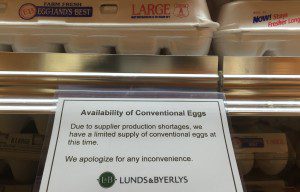How Bird Flu is Impacting the Egg Supply Chain
 As I mentioned in last Friday’s news round-up, the United States will begin to import eggs from Europe due to a massive shortage. This marks the first time in more than a decade that the US has been forced to import eggs. The cause of the shortage is avian flu. According to the US Department of Agriculture, the ongoing avian flu outbreak has affected more than 47 million birds. There are approximately 300 million birds raised for the purpose of laying eggs in the country; with 47 million having been affected by avian flu, that is nearly 16% of the stock. With so many birds wiped out, the egg supply chain is feeling the pressure.
As I mentioned in last Friday’s news round-up, the United States will begin to import eggs from Europe due to a massive shortage. This marks the first time in more than a decade that the US has been forced to import eggs. The cause of the shortage is avian flu. According to the US Department of Agriculture, the ongoing avian flu outbreak has affected more than 47 million birds. There are approximately 300 million birds raised for the purpose of laying eggs in the country; with 47 million having been affected by avian flu, that is nearly 16% of the stock. With so many birds wiped out, the egg supply chain is feeling the pressure.
So what affect does the egg shortage have on businesses and consumers? It is more far reaching than one might think. Eggs are sold in two basic varieties to businesses: liquid eggs and shell eggs. Liquefying eggs is an on-farm process where chickens lay eggs, which are then broken, liquefied, and frozen or dried. These eggs are used in dozens of products, from cookies and cakes to mayonnaise and breakfast dishes. For businesses that rely on the liquid eggs, the avian flu outbreak has been particularly tough, as the majority of avian flu deaths have come at these facilities. With such a limited supply available, prices have shot up 240% since May. And now most bakeries cannot get their hands on enough eggs to keep their operations going.
 With prices soaring and availability plummeting, this proves to be a tough time for businesses that rely on liquid eggs. The end result is fewer products sold to consumers at much higher prices to offset increasing costs and a shortage of goods. And this impact goes far beyond just baked goods. Every food item that uses liquid eggs, from mayonnaise to salad dressings, is feeling the pinch. The prices have risen so rapidly, however, that supermarkets have not yet been able to pass on the entire added costs to consumers. But that will change soon. Practically every item that has egg as a primary ingredient is going to feel the pinch.
With prices soaring and availability plummeting, this proves to be a tough time for businesses that rely on liquid eggs. The end result is fewer products sold to consumers at much higher prices to offset increasing costs and a shortage of goods. And this impact goes far beyond just baked goods. Every food item that uses liquid eggs, from mayonnaise to salad dressings, is feeling the pinch. The prices have risen so rapidly, however, that supermarkets have not yet been able to pass on the entire added costs to consumers. But that will change soon. Practically every item that has egg as a primary ingredient is going to feel the pinch. The good news for consumers is that more than two-thirds of the eggs produced in the US remain in the shell. And this industry has not been hot nearly as hard. So while there has been a decline in the inventory available, prices have not risen significantly yet. However, some grocery chains are being proactive in their approach to the shortage. H-E-B Texas Grocery, for example, has begun to limit the number of egg cartons customers can buy at one time.
The good news for consumers is that more than two-thirds of the eggs produced in the US remain in the shell. And this industry has not been hot nearly as hard. So while there has been a decline in the inventory available, prices have not risen significantly yet. However, some grocery chains are being proactive in their approach to the shortage. H-E-B Texas Grocery, for example, has begun to limit the number of egg cartons customers can buy at one time.
Fast food restaurants are also feeling the pinch. As eggs have grown in popularity lately, mainly thanks to research showing the health benefits of the healthy protein, restaurant chains like McDonald’s and Whataburger have ramped up breakfast hours. As a result of the avian flu, Whataburger has limited the service of eggs to part of their full-scale breakfast hours. Other chains have begun to look at egg substitutes as a viable option for the egg shortage.
 So while the US is now beginning to import eggs from Europe, this adds more steps in the supply chain, and more costs on to the consumer. With the shell egg shortage at a much lower level than the liquid egg shortage, the majority of imports will come in liquid egg form. While most experts agree that the avian flu seems to be more contained, and that flu cases are the decline, imports will not be a simple short term fix. It is going to take months for flocks to rebuild. The infected farms have to sit idle for six weeks after the birds are destroyed before they can resume operations. Additionally, young hens do not begin laying eggs until they are about five months old. This puts a minimum of six months before these farms are fully up and running again. Until then, shell eggs and imports will have to do the trick.
So while the US is now beginning to import eggs from Europe, this adds more steps in the supply chain, and more costs on to the consumer. With the shell egg shortage at a much lower level than the liquid egg shortage, the majority of imports will come in liquid egg form. While most experts agree that the avian flu seems to be more contained, and that flu cases are the decline, imports will not be a simple short term fix. It is going to take months for flocks to rebuild. The infected farms have to sit idle for six weeks after the birds are destroyed before they can resume operations. Additionally, young hens do not begin laying eggs until they are about five months old. This puts a minimum of six months before these farms are fully up and running again. Until then, shell eggs and imports will have to do the trick.
No comments:
Post a Comment